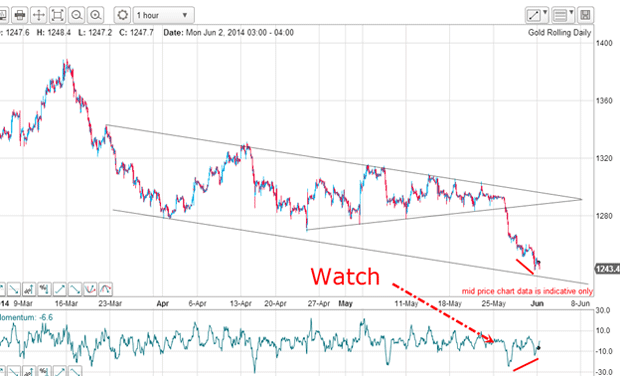How to think like a successful trader
Take the element of luck out of your trading by sticking to your simple, yet effective spread-betting system, says John C Buford.
I am reading a terrific book which I recommend to serious traders: Thinking, Fast and Slow by the Nobel Prize-winning economist and psychologist Daniel Kahneman.
In it, he explains that we have two modes of thinking: system one, which is intuitive and is quick to come up with answers from limited information (gut reactions), and system two, which is more considered and oversees and modifies system one. Often, the two responses are in conflict - that is where most of us live.
But what is of great interest to traders is the chapter called "The illusion of validity". In example after example, Kahneman relates how experts were often no better at predicting events than an application of a simple algorithm using inputs of only a few variables.
MoneyWeek
Subscribe to MoneyWeek today and get your first six magazine issues absolutely FREE

Sign up to Money Morning
Don't miss the latest investment and personal finances news, market analysis, plus money-saving tips with our free twice-daily newsletter
Don't miss the latest investment and personal finances news, market analysis, plus money-saving tips with our free twice-daily newsletter
So today, I'm going to tell you about Kahneman's findings and how this can improve your trading. Also, I'll be giving an update on what's happening in the gold market
Do good financial advisors just get lucky?
This data was used every year to determine employee bonuses solid returns from superior stock-picking was supposed to be rewarded by fatter bonuses.
Kahneman was interested in seeing if there was a consistency from year to year between the advisors. He reasoned that if there was at least one advisor with a consistent performance, he could attribute it to skill. Basically, he found the correlation coefficient as close to zero as made no difference!
Naturally, at the seminar, the advisors were not overly thrilled to be told that stock-picking is largely down to luck but there was the proof staring them in the face.
And this is the human part: the evidence was right in front of them, but the advisors chose to ignore it. This is totally understandable and rational: if they did not, they would likely get out of the business and have to find another career. And who wants to quit a very high-paying and secure job for a big unknown?
There are very few of us who would do that. So we push the system two response (conflict) under the rug and continue with business as usual.
The easy way to become a better trader
The examples in Kahneman's book show that most experts suffer from over-confidence in their predictions simply because their superior research and knowledge has resulted in naturally rather elevated egos.
This leads to them making predictions not based on evidence, but on wanting to be flamboyant and stand out. They become hyper-competitive and that helps book sales!
Also, it is well-known that most people hate to admit they are wrong. They are lead astray by how they think. They cling to their statements/beliefs for dear life simply because they believe they would be destroyed if they admit error.
There is also the herding effect, where many people believe in the preposterous simply because their chosen guru has uttered it, and it has been confirmed by so many others.
That is the basic dynamic behind my observation that bull markets always turn when bullish sentiment is at extremes (when most have bought into the bull's story).
Incidentally, I disagree with Kahneman that trading is all down to luck (after all, he is an economist). My trading method is one that offers a logical means to successfully exploit the markets, as I show in these posts.
My very simple system is equivalent to the algorithm I mentioned above with only three input variables (tramlines, Fibonacci and basic Elliott wave theory). It is based on an objective reading of the price charts (system one and two are in harmony).
There's unusual activity in the gold market

Note the very accurate hits on my wedge lines even the four spike lows on the lower line are accurate. This is unusual, especially in gold, and to be noted.
But now, there is a possible positive-momentum divergence growing and a warning that a counter-trend rally could start at any time. One way to play this is to use a trailing stop on your short trade.
But my other triangle target in the $1,200 area stands, and this would require a break of my lower tramline.
The market is headed down
| (Contracts of 100 troy ounces) | Row 0 - Cell 1 | Row 0 - Cell 2 | Row 0 - Cell 3 | Open interest: 397,695 | ||||
| Commitments | ||||||||
| 155,615 | 82,224 | 35,612 | 162,078 | 240,716 | 353,305 | 358,552 | 44,390 | 39,143 |
| Changes from 05/20/14 (Change in open interest: -1,676) | ||||||||
| -1,783 | 21,317 | -2,580 | -2,211 | -29,583 | -6,574 | -10,846 | 4,898 | 9,170 |
| Percent of open in terest for each category of traders | ||||||||
| 39.1 | 20.7 | 9.0 | 40.8 | 60.5 | 88.8 | 90.2 | 11.2 | 9.8 |
| Number of traders in each category (Total traders: 263) | ||||||||
| 107 | 81 | 70 | 58 | 48 | 199 | 171 | Row 8 - Cell 7 | Row 8 - Cell 8 |
This data is current to last Tuesday the very day the market broke my lower wedge line. The previous week saw a big swing to the bearish side by the hedgies (non-commercials) as well as the small speculators (non-reportables).
But both groups of speculators remain net long, and my guess is that before this down move ends, there will be a further swing by the speculators to the bearish side.
And that will provide the fuel for the massive rally that I expect.
We shall see. But for now, the market is headed down.
Get the latest financial news, insights and expert analysis from our award-winning MoneyWeek team, to help you understand what really matters when it comes to your finances.
John is is a British-born lapsed PhD physicist, who previously worked for Nasa on the Mars exploration team. He is a former commodity trading advisor with the US Commodities Futures Trading Commission, and worked in a boutique futures house in California in the 1980s.
He was a partner in one of the first futures newsletter advisory services, based in Washington DC, specialising in pork bellies and currencies. John is primarily a chart-reading trader, having cut his trading teeth in the days before PCs.
As well as his work in the financial world, he has launched, run and sold several 'real' businesses producing 'real' products.
-
 Rachel Reeves confirms ‘workaround’ for pensioners facing tax bill on state pension
Rachel Reeves confirms ‘workaround’ for pensioners facing tax bill on state pensionAs the full new state pension looks set to breach the tax-free personal allowance within years, the government has said anyone on just a state pension won’t have to pay income tax on the payment until the end of this parliament
-
 Zoopla: House prices in southern England drop for first time in 18 months
Zoopla: House prices in southern England drop for first time in 18 monthsHouse buyers could benefit from a fall in prices, triggered by a rumoured ‘property tax’ prior to the Budget, as Zoopla revealed lower prices for the first time in 18 months
